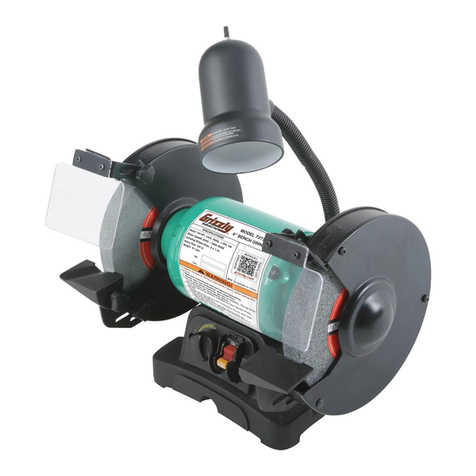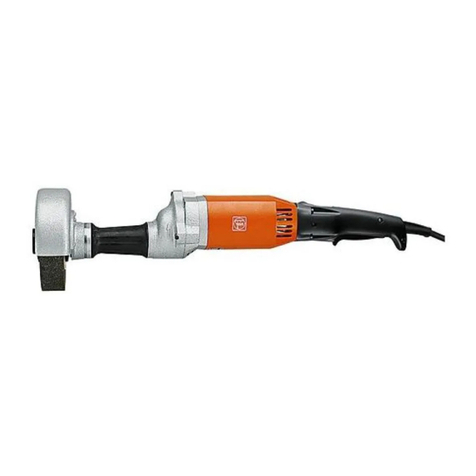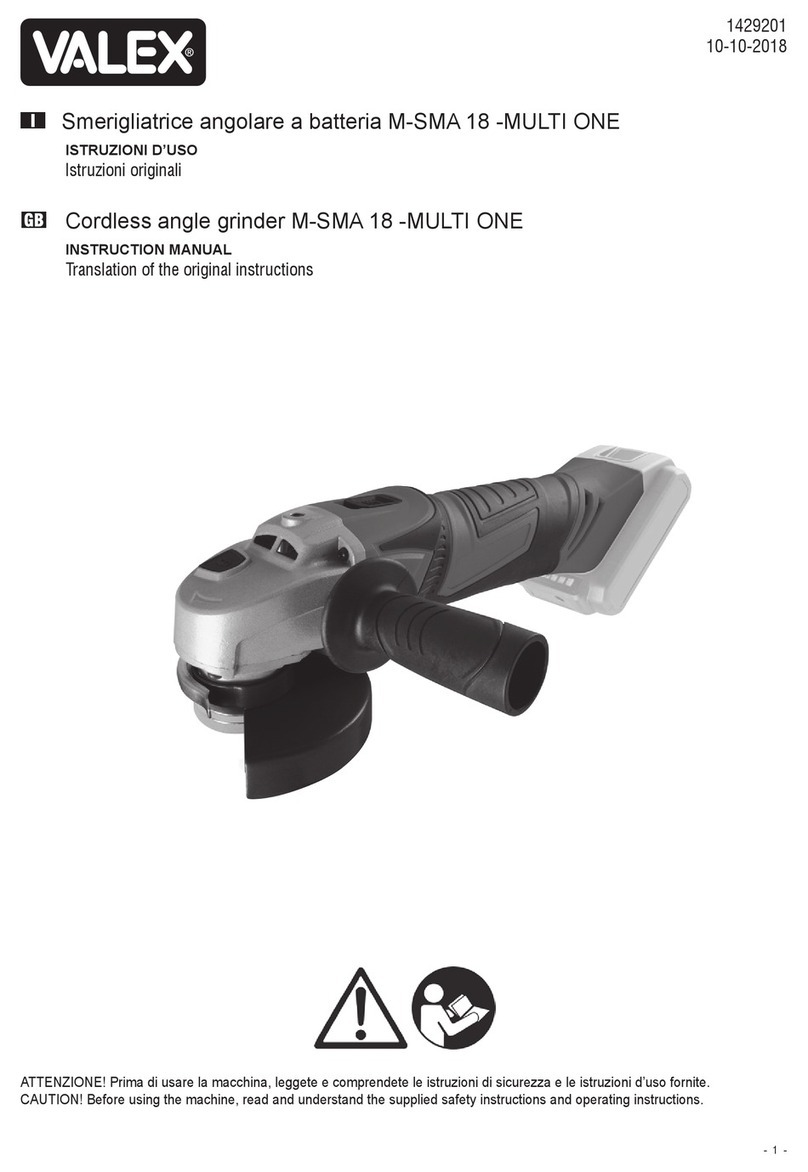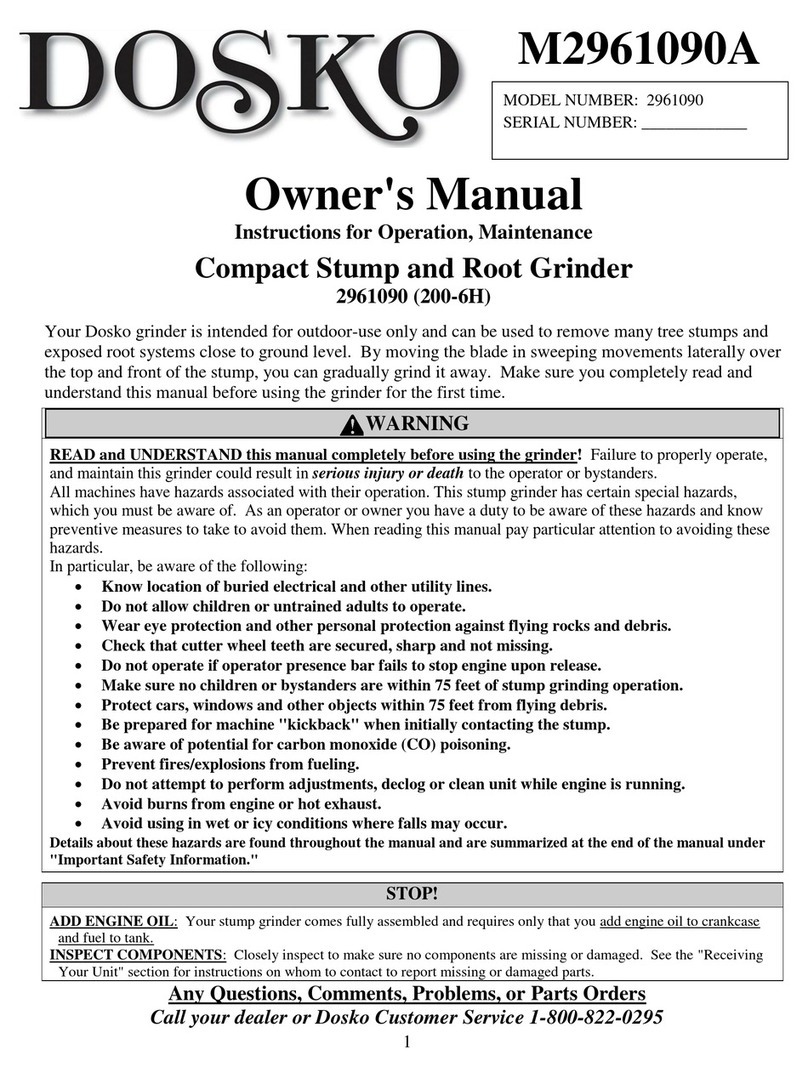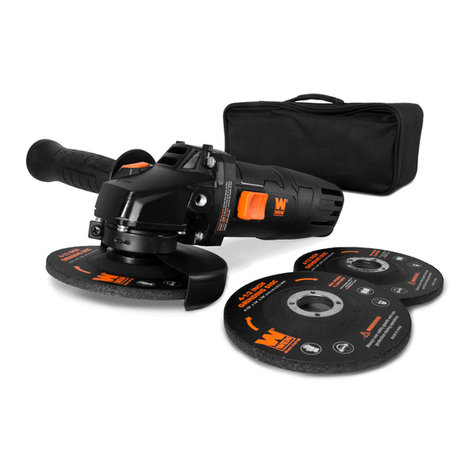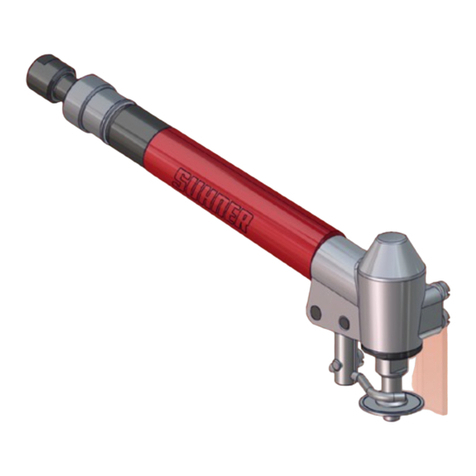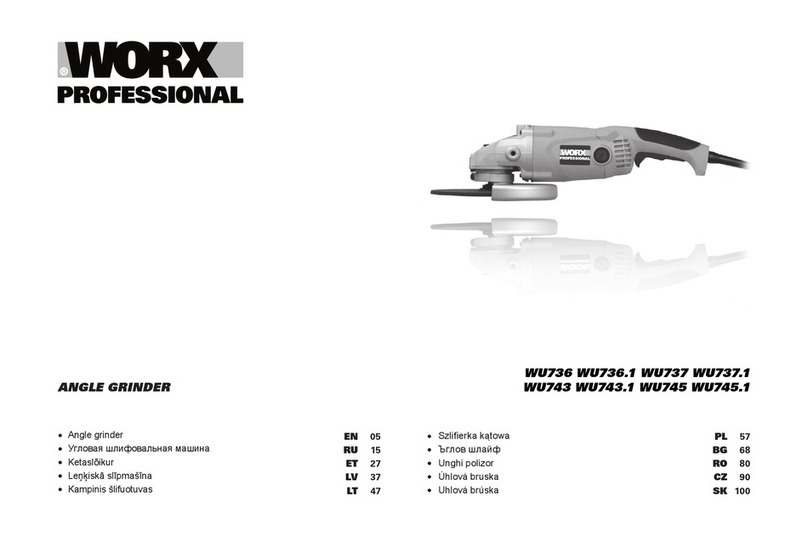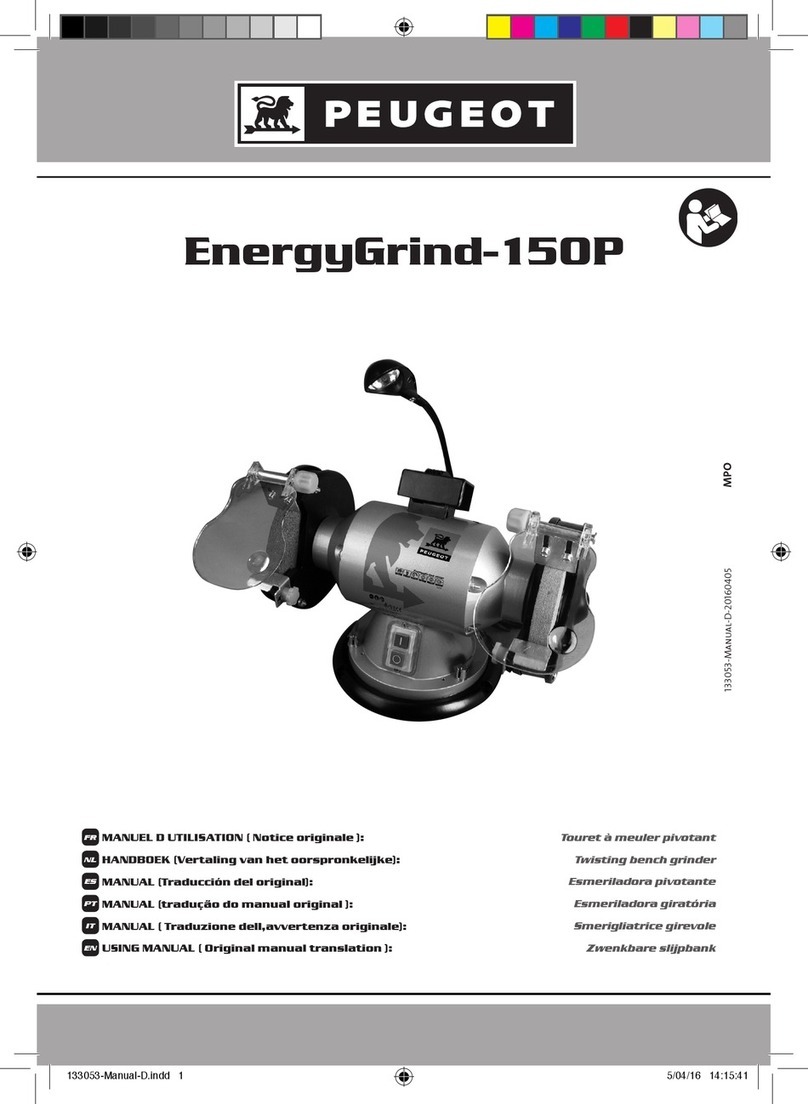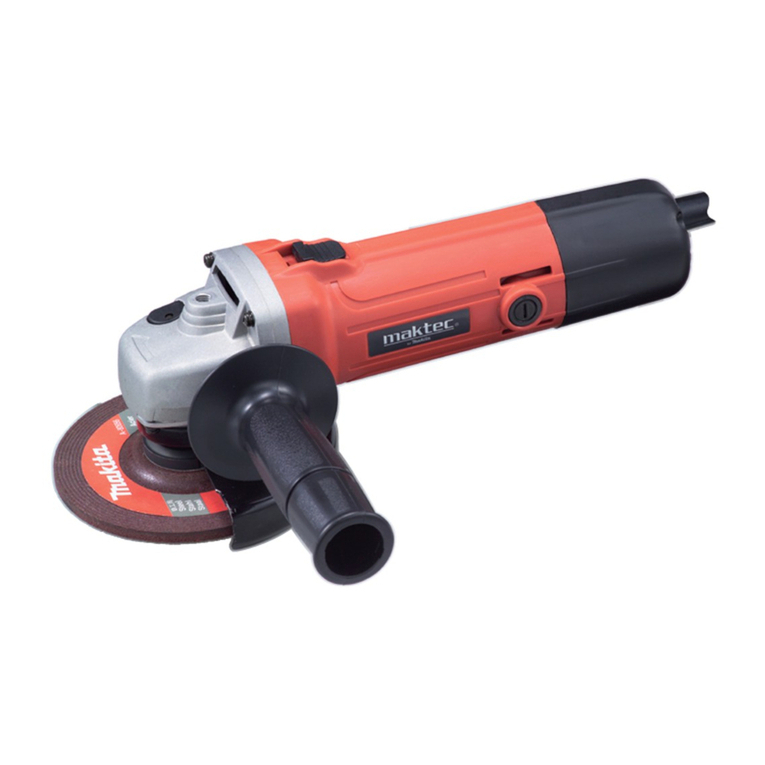DIXIE GRINDERS 11-10 User manual

DIXIE GRINDERS INC.
1324 RAILROAD AVENUE GUNTERSVILLE, AL 35976
(800) 745-0586 (256) 582-0477 FAX (256) 582-0478
MODEL 11-10
GRINDER UNIT
SAFETY INSTALLATION OPERATION MAINTENANCE
THIS MANUAL MUST BE READ TO,
OR BY EACH PERSON, BEFORE
THAT PERSON OR DEPARTMENT
UNCRATES, OPERATES,
MAINTAINS, OR SUPERVISES USE
OF THIS MACHINE IN ANY WAY.
CAUTION

1
DIXIE
GRINDERS
INC.
TRIPLE
PLATE
ASSEMBLY

2
IMMEDIATE HAZARDS
WHICH WILL RESULT IN
SEVERE PERSONAL INJURY
OR DEATH.
HOPPER GUARD
LISTED BELOW IS THE DEFINITION OF THE HAZARD
LEVEL USED ON THE SAFETY STICKERS.
TYPICAL DIXIE 11-10 GRINDER UNIT
FRAME
MOTOR
COVER
PANELS
SERIAL
NUMBER
HOPPER
RING
BELT
GUARD
HEAD
GEARBOX
SAFETY TAG
ORIFICE
PLATE
GUARD
GEARBOX
TAG

3
INTRODUCTION
A Grinder Unit is a type of size reduction
machine. Its primary purpose is to grind
meat, meat by-products, and other similar
products.
The primary grinding components are a plate
retaining ring, orifice plate, plate bushing,
knifeholder with knife inserts, centering pin,
spring or springs, head, feedscrew, hopper,
gearbox, and drive pulleys. In most instances
an electric motor drives the grinder unit.
This unit is mounted on a undermount frame
(as shown on cover) or sidemount frame.
Standard safety equipment includes a belt
guard, a hopper guard, and a plate guard. If a
transition funnel is used, the plate guard is not
required.
It is important that your application, and/or
installation does not render these guards
ineffective. If for any reason you believe these
guards are not adequate, do not use the machine
and call Dixie Grinders Inc. at once. (256) 582-
0477 OR (800) 745-0586.
This machine was sold for a specific application.
If you are not familiar with the application that
this unit was sold for, check with Dixie Grinders
Inc. before using the machine.
All operators and sanitation personnel should
read this manual and understand it.

TAG D 1 EA. (ON GEARBOX)
TAG C 2 EA. (ON FRONT OF
HOPPER AND FRONT OF FRAME)
TAG B 2 EA. (ON BELT GUARD
TAG A 2 EA. (ON SIDES OF HOPPER) AND ON HOPPER FRONT) 4
THE HOPPER GUARD AND PLATE
GUARD MAY NOT BE ATTACHED
FOR SHIPPING!
THE HOPPER GUARD IS
PROVIDED TO RESTRICT
ACCESS TO THE ROTATING
FEEDSCREW!
THE PLATE GUARD IS
PROVIDED TO RESTRICT
ACCESS TO THE PLATE, THE
KNIFEHOLDER, AND THE
FRONT END OF THE
FEEDSCREW!
THE BELT GUARD IS
PROVIDED TO RESTRICT
ACCESS TO THE V BELTS
AND THE ROTATING
PULLEYS!
4.84B
192
11-10
08-023
FAILURE TO USE GUARDS WHILE THE
GRINDER UNIT IS IN OPERATION MAY
RESULT IN SEVERE INJURY OR DEATH!
REPLACE SAFETY TAGS WHEN
NECESSARY! CALL DIXIE GRINDERS
INC. FOR REPLACEMENT SAFETY TAGS.

SITE CONSIDERATIONS:
It is important that the permanent position of
the grinder unit provides clearance of several
feet behind, to either side, and approximately
eight feet or more in front of the grinder unit.
If the grinder is set on a stand, or leg extensions
are attached, an adequate platform must be
provided to provide safe access to the grinder
unit. It will be necessary to have an approved
platform or device to provide access so the unit
can be properly sanitized, disassembled,
assembled, and maintained. Consideration
must be given to allow for complete service to
the grinder unit.
Platforms should be so designed not to make
the hopper guard, or other guarding,
ineffective. The hopper guard is not a hopper
for holding a large amount of material, it is
designed to keep the operator away from the
feedscrew. If the location of this grinder unit
compromises this feature, special guarding may
be necessary. Consult your Safety Engineer,
Plant Engineer, and O.S.H.A. for all regulations
related to the guarding of this machine.
Only the feedscrew puller and ring lift can be
attached to the grinder unit directly. Do not
use the grinder frame to support other
equipment without prior approval from Dixie
Grinders Inc. The grinder frame is not to be
used as a personal stand, and under no
circumstances should anyone be allowed to
climb on it or use it as a platform. Remember
to Work Safely!
"THE GRINDER HAS ARRIVED"
LIFT EQUIPMENT REQUIRED:
We recommend using a 5,000 pound capacity
fork lift with 48" or longer forks. Do not
attempt to unload the grinder unit from a
commercial van from ground level! Only
authorized and properly trained equipment
movers should attempt to unload the grinder
unit. Remember to Work Safely!
PRE-UNLOADING INSPECTION:
Before the grinder unit is unloaded, inspect the
unit for any damage before unloading. If the
machine is damaged consult your management,
the trucking company, and Dixie Grinders Inc.
before unloading the machine!
UNLOADING GRINDER UNIT:
With the commercial van properly chocked and
secured to the loading dock, and using only
approved and adequate dock plates should any
attempt be made to unload this machine. Lift
only under the grinder frame, never attempt to
pick up a grinder from the hopper or gearbox.
The forks should be long enough to extend
beyond the end of the frame a safe distance.
Unload the grinder unit and all parts that have
been shipped with the grinder unit. Consult the
packing slip to insure that all pieces have been
unloaded.
UNPACKING:
When the grinder has been properly unloaded it
should be placed in a suitable location for
unpacking. The belt guard protector and the
shipping skids may be removed. Remove any
spare parts that may have been shipped in the
grinder hopper. Use appropriate equipment
and appropriate personal safety equipment in
this process. Remember to Work Safely!
5

UNIT CONTROLS.
Dixie Grinders Inc. does not supply motor
controls, starters, stop/start stations,
disconnects, or other related equipment that is
required to control the function of the grinder
unit.
INSTALLATION:
The machine can be installed in its permanent position
after the skidding has been removed. Use only
adequate equipment and properly trained personnel to
install the grinder in its permanent position. Use great
care in moving this equipment, it is heavy and must
not be tipped, tilted, jarred or jammed into position.
We recommend a 1° slope to allow water to drain from
the grinder unit.
We recommend serious consideration is given
to the location of the start/stop station.
We strongly recommend that additional stop
stations are located where deemed appropriate.
Disconnects that can be locked out should be so
located that employees that have to operate,
service, and sanitize the unit can lock the unit
out. Each employee that has to work on this
machine should be given a lock and key and
trained in proper procedures for LOCK
OUT/TAG OUT!
Please consult with your Safety Engineer, your
Electrical Engineer, and O.S.H.A. for all
regulations related to the controls and wiring
for this machine.
We do not recommend the use of wye-delta or
star delta starters. In some areas this is
required. If your machine must be wired this
way the operators must understand that they
cannot begin to grind product until full power
is supplied to the grinder feedscrew. If there is
product in the grinder hopper before the unit is
turned on, the grinder may not have enough
torque to start grinding in the reduced torque
condition.
Frequency controllers are very useful, but with
the exception of a grinder connected directly to
a pump unit or mechanical deboner, the use of
a frequency controller on a grinder unit is
usually not necessary. We do recommend a
frequency controller or some form of speed
control is used to feed the grinder, and often to
take the product away from the grinder.
We do not recommend remote operation of any
grinder unit unless special precautions are
taken, and that all possibilities of employee
injury are eliminated.
6

DISASSEMBLY TOOLS:
If the grinder is not located on floor level
make no attempt to disassemble the grinder
unit without an adequate platform or
provisions provided by the installation
contractor, plant engineer, or plant safety
officer. The grinder has many parts that
have square edges and cutting edges.
Adequate safety equipment should be used
at all times!
After the grinder has been installed in its
permanent position, it can be disassembled.
The tools described below are for both
disassembly and assembly of the grinder
unit.
The end of the ring wrench fits into the end
of the feedscrew and it can be used to
engage the feedscrew to the drive spline.
Plate Lifter
This is used to
remove the plate
and bushing from
the grinder unit, or
on assembly to
install the plate and
bushing into the
grinder unit.
Note:
Wear appropriate safety equipment and
remember to always "Work Safely".
7
Ring Wrench / Worm insertion tool
The Ring Wrench fits over the lugs of ring and
is used to loosen the ring (counter clockwise),
or tighten the ring (clockwise)
When the grinder unit has been properly
secured, disassembly can begin.

Dropping the ring on the end of the pin will
damage the threads each and every time. There
is no maybe, the threads are damaged and they
need to be fixed. Trying to screw a damaged
ring or chamber ring onto the head or the next
chamber ring will destroy the mating threads
making the mistake a bigger one, now costing
over twice as much to fix.
With the grinder unit properly secured,
disassembly can begin.
Step 1. Using the ring wrench, loosen the ring
by exerting downward pressure, as shown,
turning the ring counter clockwise.
GRINDER UNIT DISASSEMBLY:
READ AND UNDERSTAND THE
FOLLOWING TAG.
Use the ring wrench only to loosen the ring.
When the ring can be turned by hand,
discontinue using the ring wrench.
When the ring has been loosened, turn it off
by hand. Depending on the ring type, the ring
may weigh up to 65 lbs. If this is more than
you can lift, get help. Use the ring remover if
your machine has been equipped with one. Do
not attempt to remove the ring if you are out
of position, or if the ring is higher than the
center of your chest, or if you cannot lift this
much on your own!
8
Step 2. Remove the 1453 slip in bushing from
the final plate. You may use the plate
remover or carefully use a screw driver. Do
not, under any circumstances, bump the
grinder on to remove the last plate and
bushing. The power should be locked out and
remain locked out during grinder
disassembly!
Step 3. Remove the third or final plate.
Use plate remover if necessary.

Step 4 continued, removing 3rd knifeholder,
#1978.
Step 4. Remove the 3rd knifeholder. The
inserts are sharp so be carefull. If necessary
wear gloves.
9
Step 5. Remove the third set of washer
springs, #2578.
Step 3 continued. It may be necessary to
wiggle or rock the #1118 X 1/8" plate in
order to remove it.

For 1/8" spacing this
side out.
Check for nicks, dings, and dents caused by
tramp metal in your product. Notice the nice
sharp corners on the new 10026 impeller,
pretty isn't it?
Step 6. Remove the #10026 impeller. Edges
may be sharp, wear protective gloves if
necessary.
Step 7. Remove the impeller spacer, #10118.
This may not be in the machine at all times, see
assembly instructions. The impeller spacer is
used to keep the impeller spaced away from the
second plate.
For 1/4" spacing this
side out.
10
Note what direction the impeller spacer is on
the pin if you will be using the same
knifeholders and plates. The impeller spacer
can be placed over the square shoulder to
provide 1/8" spacing, or place flush with the
shoulder to provide 1/4" spacing. Neat huh!

Step 11. Remove the #10035 springs.
Step 9. Remove the second plate, #1118 x
3/16". The second bushing #10031 slides into
the plate from the back side. Notice the recess
in the face of the knifeholder that provides
clearance for the bushing.
Step 10. Remove the #10032 4-bladed
knifeholder.
11
Step 8. Remove the first chamber ring.
Using the ring wrench, loosen the ring until it
can be turned by hand. If you are out of
position, or cannot lift heavy items, get help.
As mentioned with the ring, dropping the
chamber ring on the centering pin will
damage the threads.

Step 12. Remove the #2579 impeller.
Step 14 continued. Remove the first plate,
#1115 x 5/16". The first bushing #2573 slides
into the plate from the back side. Notice the
recess in the face of the knifeholder that
provides clearance for the bushing.
12
Step 13. Remove the second chamber ring,
#2577. I won't say don't bang up the threads
this time around, ok? Or hint that it might be
to heavy for you and you might need help
lifting it.
Step 15. Remove the #2572 four-bladed (or
#2991 two bladed) knifeholder. The #1991
inserts may be sharp so be carefull. You may
wish to wear gloves to protect your pinkies.
Step 14. Remove the #1115 x 5/16" plate.

Step 16. The hand is removing the #2938
springs, notice that these also have one spring
facing inward and one facing out.
OUTWARD
FACING
SPRING
Step 17. Remove the #2937 spacer collar.
It may be necessary to hold the feedscrew in
while pulling the pin out.
Step 18. Remove the pin, notice how the pin
key was caught with the other hand!
INWARD
FACING
SPRING
13

With the feedscrew removed from the grinder unit, it can now be wired. Dixie Grinders Inc. does
not supply motor controls, disconnects, or stop/start stations. Please consult your Electrical
Engineer, your Safety Engineer, OSHA, and other Federal, State, and local regulations.
With the pin out of
the feedscrew, you
can now remove
the feedscrew from
the rest of the
grinder unit.
Step 19. REMOVE THE FEEDSCREW FROM THE GRINDER UNIT.
We recommend using our Model FSP2005 to remove the feedscrew (see next page). If you do not
have a FSP2005 feedscrew puller, we recommend using a feedscrew cart, chain hoist, or other
suitable lifting device.
The feedscrews are heavy, 300 to over 400 pounds. Do not attempt to remove the feedscrew by
hand.
The feedscrew needs to be handled carefully so that the outside diameter is kept free of nicks and
burrs. Be careful, the feedscrew has sharp corners that can cut, the cupping is sharp!
Wear appropriate safety equipemnt and remember to always "Work Safely".
14

ROTATION: When the grinder unit has
been disassembled, and then wired
according to all applicable codes and
regulations, rotation can be checked. Do
not turn the unit on until you are positive
that no one is in harms way! The grinder
feedscrew should turn counterclockwise!
After the rotation has been checked
LOCK OUT THE POWER!
SANITATION: Appropriate clothing
should be worn, and all safety precautions
should be taken before cleaning any
equipment. Typical grinder units have tin
plated feedscrews, heads, rings, and often
the grinder hopper is also tin plated. Before
you begin to clean your machine, make sure
any commercial cleaning agents are
approved for cleaning tin plated surfaces.
If no mention of tin is on the label but the
cleaner is not recommended for aluminum
do not use it unless you have contacted the
cleaner manufacturer for their
recommendations. Do not use high pressure
streams of water to clean a grinder unit. It
is possible to drive water past the oil seals
and damage the gearbox.
Do not allow any cleaning agent to sit on the
tin plated surfaces for an extended period of
time. Apply the soap, and rinse it off
immediately!
After cleaning, rinse the unit with large
quantities of hot water. We strongly
recommend drying the unit and applying a
liberal amount of mineral oil to all tin plated
surfaces. If the machine is not going to be
used for an extended period, apply a coat of
edible grease to all surfaces and wrap the
grinder in plastic.
SANITIZERS: Iodine sanitizers. Iodine
reacts with tin. If the Iodine is in sufficient
strength and has been on the tin plated
surfaces long enough it will turn anything
that touches the surface deep purple. Other
sanitizers also may react with tin plated or
stainless steel surfaces. Check label
instructions before using. If you notice that
the tin plating is coming off of your grinder
unit contact Dixie Grinders Inc.
UNIT ASSEMBLY: Please study all of the
grinder parts shown on the exploded view
before you attempt to assemble the grinder
unit. The exploded view is at the rear of the
maintenance instructions. (These instructions
assume that the grinder unit has not been
disassembled any further than the instructions
already given.)
MAKE SURE THE POWER IS
STILL LOCKED OUT BEFORE
ASSEMBLY.
Step 1. INSTALL FEEDSCREW.
Using the Model FSP2005 feedscrew puller,
or other device, install the feedscrew into the
grinder unit. Do not attempt to install the
feedscrew by hand, or by yourself. You will
notice that when using the FSP2005 the
feedscrew usually engages on the drive spline
with little effort. If you are not using the
FSP2005 it will be necessary to use the
handle end of the ring wrench.
15

If the feedscrew does not slide up on the
spline, it may be necessary to push down
and in, while turning the feedscrew slightly
to engage the drive spline. Never reach into
the hopper to engage the drive spline. The
feedscrew will jump in another inch when it
is seated on the spline. Check the head
space!
3/4"
FEEDSCREW
HEAD The head space should be checked on a
weekly basis. The head space is 3/4" on
all DGI grinder units. This should be
done with the excluder seal removed.
Spacers should be added if the
measurement is more than 3/4". Spacers
should be removed if less than 3/4".
When using the ring wrench to install the
feedscrew, lift the feedscrew slightly while
pushing it in.
NOTE: THE FEEDSCREW
SHOULD NEVER RUB THE HEAD
FLUTES!
16

2 1 UNIT ASSEMBLY:
Please study all the grinder parts shown on
the exploded view before you attempt to
assemble the grinder unit. (The exploded
view follows the Maintenance section.)
(These instructions assume that the grinder unit has
not been disassembled any further than the
instructions have already given.)
Step 1. Inspect the excluder seal. It should
be clean and free of nicks, cracks, or tears.
If the excluder seal is damaged it should be
replaced.
It may be necessary to tap the excluder seal
in position. Use a rounded punch and soft
taps to help it in its proper position. Do not
use a screw driver or other pointed objects.
Push only around the center of the seal, do
not push on the soft lip. Apply force at the
hub of the seal, as shown. The lip of the
excluder seal faces out, and contacts the
hopper flange.
HEAD SPACE ADJUSTMENT.
Item 1 is our Adjustment Washer #10409
(1/16" thick) and/or Adjustment Washer
#10408 (1/8" thick). These are used with an
Adjustment Bolt #10407. Add or subtract
washers to obtain the 3/4" head space
dimension.
NOTE: This step is necessary when changing
feedscrews, heads, hoppers, or if the gearbox
has been rebuilt. Failure to set the proper
head space may result in serious damage to
the unit. If the feedscrew is allowed to rub
the head, metal particles may contaminate
your finished product!
When the Head Space has been adjusted,
remove the feedscrew so that the Unit can be
assembled for operation.
LIP OUT
Step 2. Apply a small amount of edible
grease, vegetable shortening, tallow, lard,
chicken fat, bear fat, or some other lubricant
to the face of the seal. (Check with your Quality
Control Dept. and your USDA representative for
approved materials.)
Step 3. Apply a liberal amount of this same
lubricant to the female drive spline teeth!
1
17

Step 4. INSTALL FEEDSCREW.
Using the Model FSP2006 feedscrew puller,
or other device, install the feedscrew into the
grinder unit. Do not attempt to install the
feedscrew by hand, or by yourself. You will
notice that when using the FSP2006 the
feedscrew usually engages on the drive
spline with little effort. If you are not using
the FSP2006 it will be necessary to use the
handle end of the ring wrench.
When using the ring wrench to install the
feedscrew, lift the feedscrew slightly while
pushing it in.
If the feedscrew does not slide up on the
spline, it may be necessary to push down,
in, while turning the feedscrew slightly to
engage the drive spline. B drives engage
much easier than the older A drives. The
feedscrew will jump in another inch when it
is seated on the spline.
Place the pin key into the slot in the
centering pin. Then place the pin in the
feedscrew.
Inspect the pin to make sure it is clean and
free of nicks and burrs. Replace the pin
when it shows wear grooves, checks, or is
worn.
Step 5. INSTALL CENTERING PIN.
Check adjustment bolt to make sure it is in
the pin. The pin is supplied with four
washers, start with two and the 3/4-10 x 3/4"
long hex head cap screw. This bolt is used
to space the first impeller away from the
outside of the first plate.
18

Step 6. Install
the #2937 spacer
collar over the
pin. This part
can go in either
side up.
When these springs are new the uncompressed
height of the two springs is over 1/4" as shown
above. This is how they are to be installed,
touching at the center, a gap at the outside.
One spring facing in, one facing out.
Step 7. Install the #2938 springs. Note, these are the largest of the three sets of springs.
19
Other manuals for 11-10
1
This manual suits for next models
1
Other DIXIE GRINDERS Grinder manuals

DIXIE GRINDERS
DIXIE GRINDERS 11-7 User manual
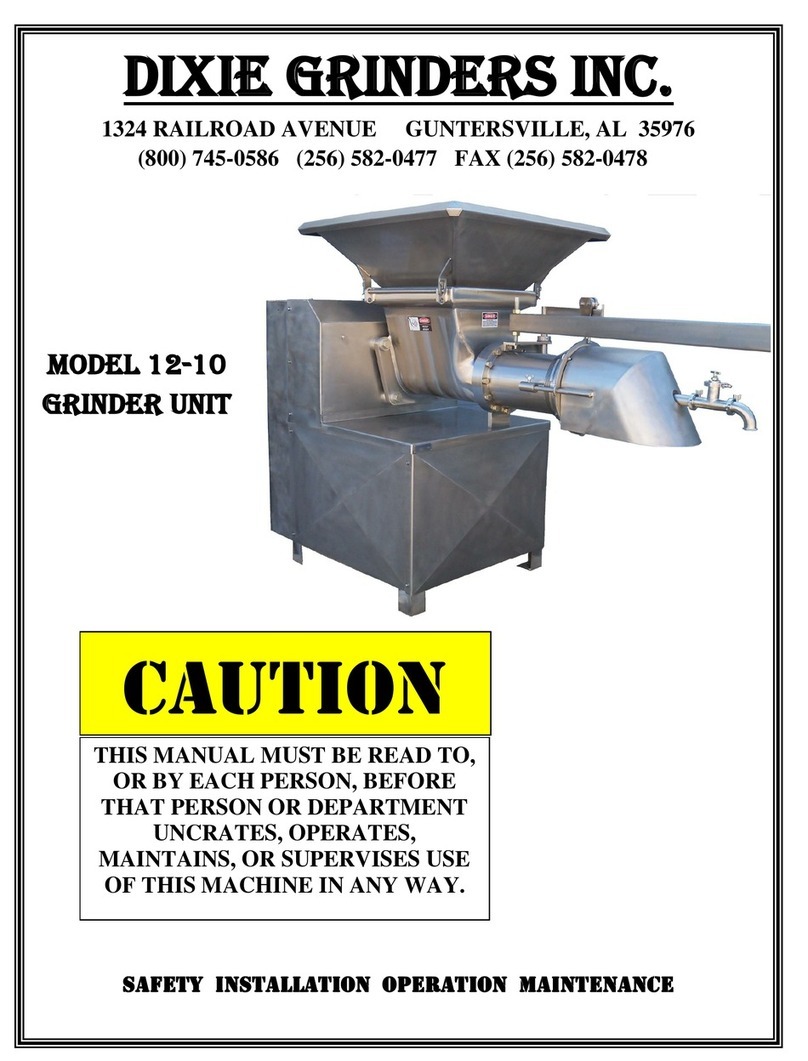
DIXIE GRINDERS
DIXIE GRINDERS 12-10 User manual

DIXIE GRINDERS
DIXIE GRINDERS 11-7 User manual
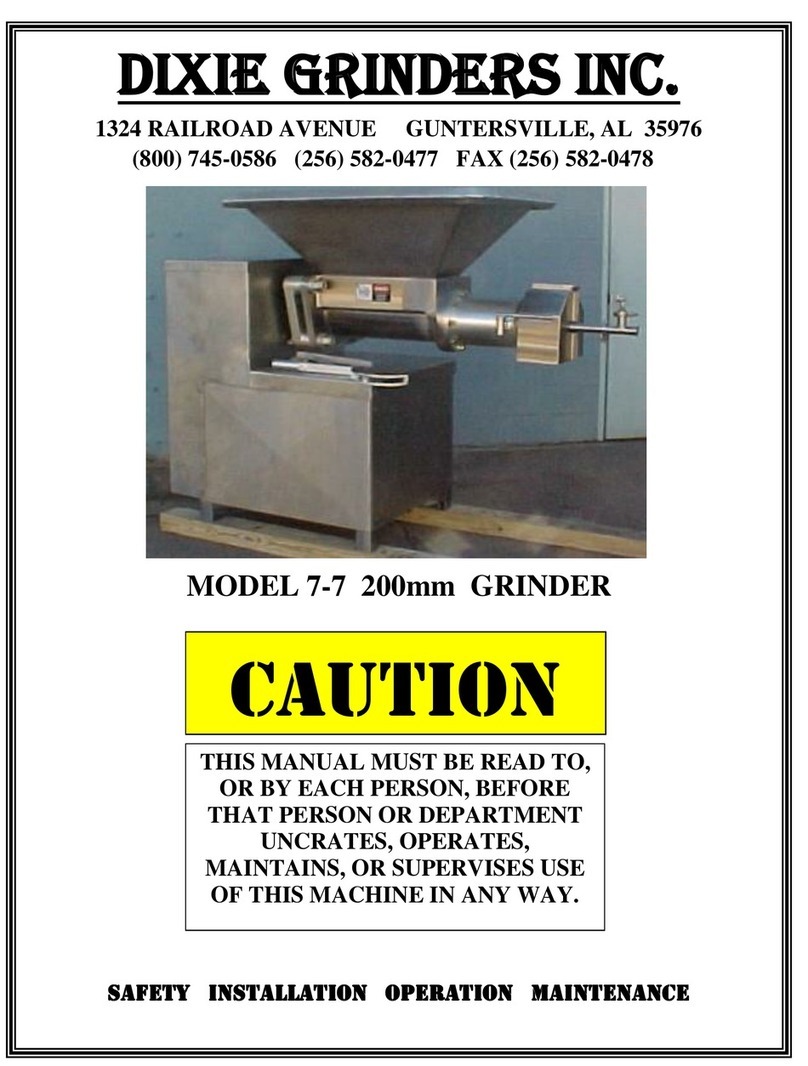
DIXIE GRINDERS
DIXIE GRINDERS 7-7 User manual
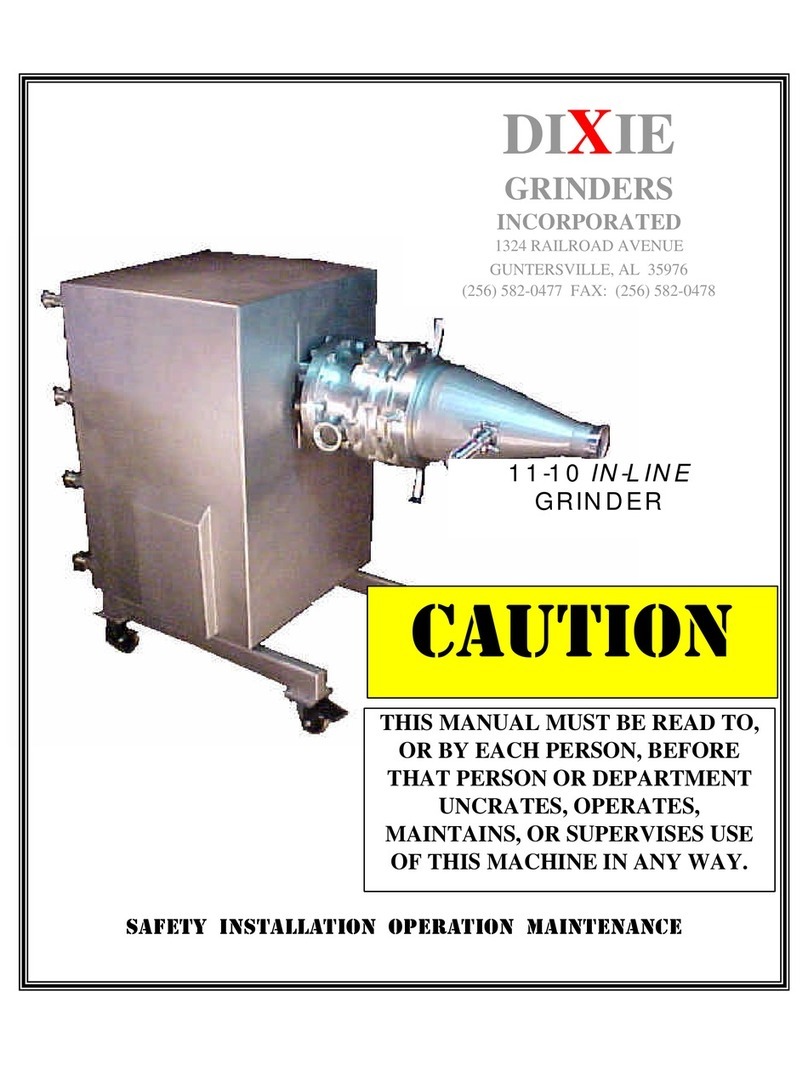
DIXIE GRINDERS
DIXIE GRINDERS 11-10 User manual

DIXIE GRINDERS
DIXIE GRINDERS 16-10 User manual
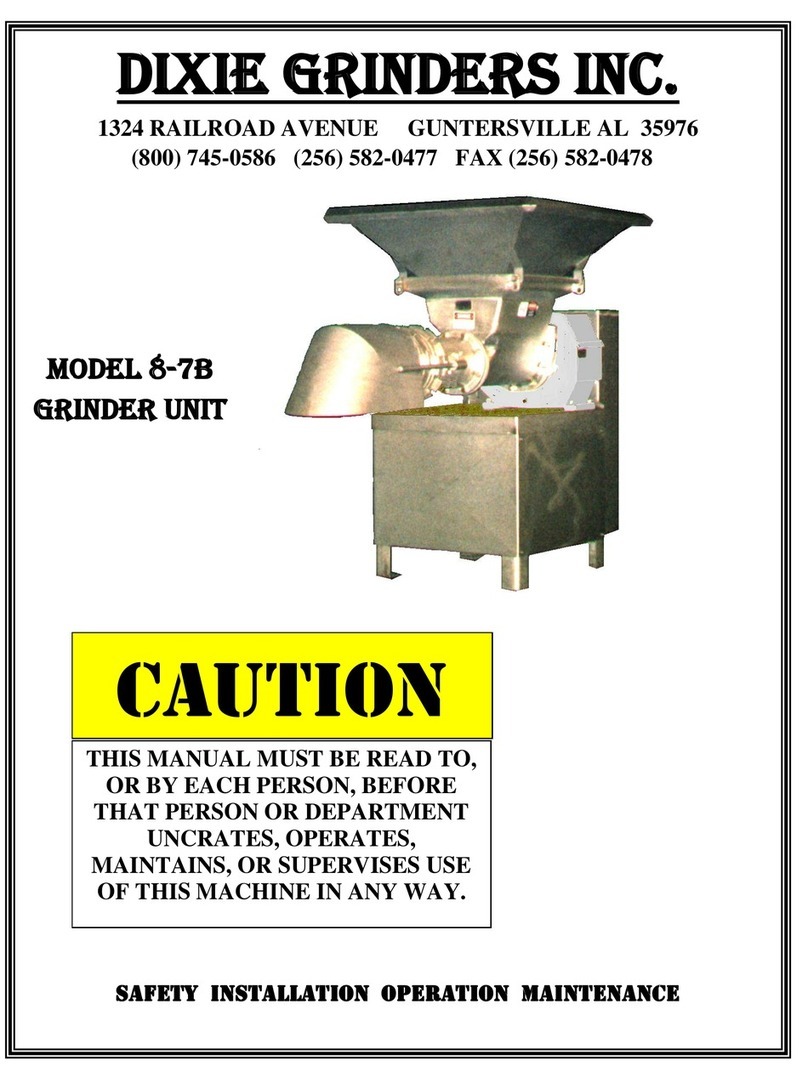
DIXIE GRINDERS
DIXIE GRINDERS 8-7B User manual
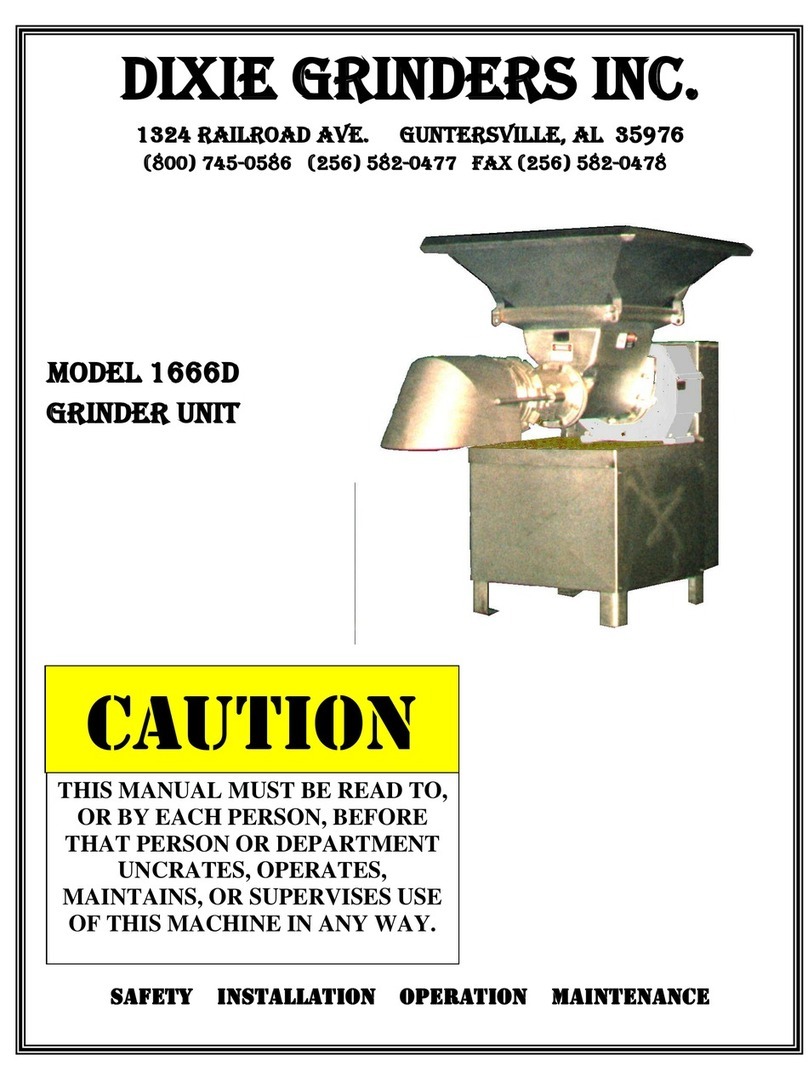
DIXIE GRINDERS
DIXIE GRINDERS 1666D User manual
